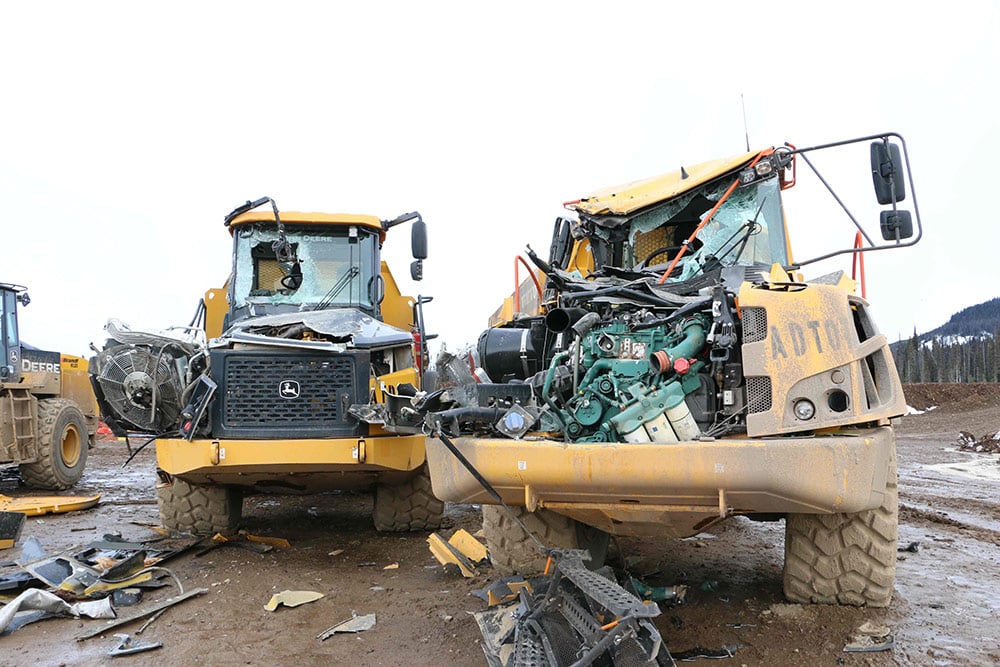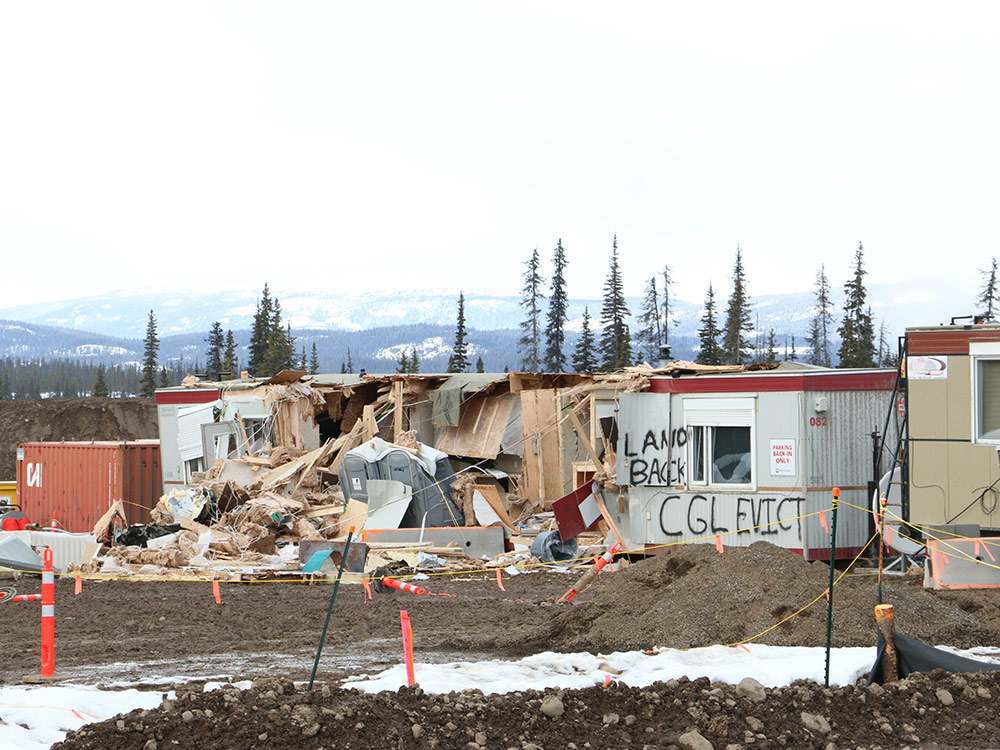At the worksite for Coastal GasLink, a row of modular buildings, apparently used as offices by the pipeline company, stand disembowelled, their contents spilling into the mud. Cables, a computer monitor and an office chair sit amongst the debris.
Directly across from the buildings, about 50 metres of security fencing lies flattened and twisted in the snow. The smell of engine fluids wafts through the air and shards of glass lie scattered beneath heavy equipment which lies crumpled, windows smashed.
An excavator at the site still grasps a piece of the torn material from a destroyed machine in its claws.
A week after the alleged attack, police say they are still trying to make sense of what took place in the early morning hours of Feb. 17. That’s when Coastal GasLink workers reported that masked assailants, some wielding axes, attacked two locations on the Marten Forest Service Road, where the pipeline company is preparing to drill under the Morice River.
While there have been no arrests, RCMP Chief Supt. Warren Brown told The Tyee this week that police were looking at possible suspects and the investigation is continuing, including combing the remote forested area and monitoring social media activity.
“Some of the people, they’ve identified themselves, who they are. So, we’ll be following up with some of the individuals,” Brown said about social media posts. “Not everybody is on their side. There are people in the territory that are not on their side. So, we’re getting some information about who may be involved.”
The Marten Forest Service Road branches off the Morice West Forest Service Road about 63 kilometres southwest of Houston, B.C. It has been the site of recent standoffs between the company and those who oppose the 670-kilometre gas pipeline under construction through northern B.C., including members of the Wet’suwet’en Nation.
While Hereditary Chiefs from all five Wet’suwet’en clans have stated their opposition to the project, five of the nation’s six Elected Band Chiefs have signed benefit agreements with the pipeline project.
In September, the nation’s hereditary leadership enforced a previous eviction order against the company and established a camp on Coastal GasLink’s drill site near the Morice River. Nation members have expressed concern about the company’s plans to drill under the river, which is known as Wedzin Kwa and is an important cultural feature of the territory.
The occupation prevented workers from accessing the site, in violation of an injunction previously granted to the company, for almost two months.
In November, RCMP moved to enforce the injunction, arresting 30 people over two days. The case against those arrested during the police action, which included police officers tearing down the door of a cabin at the drill site with axes and chainsaws, remains before the courts.
Last week’s incident was a marked escalation from previous anti-pipeline activity, which has largely involved blocking roadways and worksites. It brought calls denouncing violence and expressing safety concerns from all sides of the conflict.

It also marks the first time no one has immediately taken responsibility for the actions.
In a statement issued Saturday, all eight Wet’suwet’en Hereditary Clan Chiefs said they had been informed of the incident and were waiting for more information before speaking publicly.
“Our Elders, Dinize and Tsakë’ze [Chiefs] continue to state that we do not support violence,” the statement says.
According to a statement from the pipeline company, “approximately 20 masked and violent attackers wearing camouflage surrounded and attacked Coastal GasLink workers in a highly planned and dangerous unprovoked assault.”
The attacks took place in two locations — the drill site itself and the turnoff to the Marten road, where Coastal GasLink installed a gate following November’s police action.
The company declined The Tyee’s requests for interviews, citing the criminal investigation.
Instead, it posted the account of a security officer, identified only as Trevor, who was alone and stationed at the gate to the Marten road when his vehicle was suddenly surrounded “by a group of masked, axe-wielding assailants.” Trevor’s helmet cam footage indicates it was 12:29 a.m.
“One individual started banging on the passenger side window, demanding he open the gate,” the statement said. The individual then pulled an angle grinder out of a backpack and cut the lock.
At the same time, others began attacking the truck, the statement continued. Photos shared by the company show damage to the truck’s body and taillights. An axe, allegedly thrown through a back window, is shown inside the vehicle.
According to the account, Trevor was able to leave the area, and drove first toward Houston before encountering roadblocks erected by the group. He then headed back toward the Marten road and work camps that exist beyond.
It’s less clear what took place at the drill site, where the eight other employees, both security and pipeline workers, were also allegedly ambushed. The workers, fearing for their safety, fled the area before equipment was commandeered and used to damage the other machines and trailers at the site, according to the company. These employees also made their way to the work camp.
None of the workers were injured during the incident, Coastal GasLink said, but the company estimated damage in the millions of dollars.
The attackers disabled lighting and video surveillance at the gate and the worksite during the incident, a spokesperson said. The company has shared photos and video from cameras worn by security staff, including video released Tuesday by the RCMP.
Brown said the Houston detachment received the call for service from Coastal GasLink workers shortly after midnight on Feb. 17.
Three officers headed south on the Morice road but were blocked at about Kilometre 41, more than 20 kilometres from the drill site, by “downed trees, tar-covered stumps, wire, boards with spikes in them and fires had been lit throughout the debris,” according to an RCMP statement.
When police got out of their vehicles to remove the obstruction, assailants threw flaming sticks and gas canisters, Brown said. A banner across the road and the debris in the road was set on fire, he said.
Police estimated there were about eight suspects at the location.
“One police officer started running after one of the assailants to arrest them,” Brown said. “They lured [the officer] towards an area where there were boards with nails in them and the police officer ran over top of that, and so he had to stop because the spikes went in his feet.”
The officer received treatment and is doing fine, Brown added.
Feeling as if they were being lured into the forest, the officers decided it wasn’t safe to pursue the assailants and called for reinforcements, who didn’t arrive for several hours, Brown said. An investigation began at dawn.
“They seemed to be co-ordinated, because of the arrival time, what they were wearing,” Brown said about the various attacks. “Some had axes. Their faces were covered. It was clear their purpose was to have the workers leave the area.”
Brown said he believes the incident at the worksite occurred after vehicles dropped the assailants farther up the Morice road and they walked into the site. They would have left by the same route, he said.
But how that’s possible, with barricades in place on the roads and RCMP in the area, is unclear.
There is no other way out of the area, Brown confirmed, when asked how the perpetrators escaped.
“That’s what we’re figuring out,” he said. “What we have to do is determine who these people are and where they could have stayed, because there’s very few outbuildings, very few residences and places where people could stay. There’s the $64,000 question — who are they and where did they go?”
Brown said an RCMP checkpoint established at Kilometre 27 on the Morice following the incident is intended to monitor anyone coming in and out of the area.
Although Brown said he expected the investigation would wrap up soon and the checkpoint would be removed, security in the area remained tight over the weekend, with media access allowed only with police escort.
The Tyee visited the drill site Sunday, escorted by an RCMP officer and Coastal GasLink security.
Many have been quick to connect the incident with ongoing pipeline protests in the area.
In the B.C. legislature Tuesday, Skeena MLA Ellis Ross linked last week’s attack and previous occupations, calling it “just the latest escalation of violence.”
“You know what? The issue is actually not the violent attack in itself,” said Ross, a BC Liberal. “This is the issue of government allowing this to happen over the last five years. This is the issue of actually supporting these actions on the pipeline itself. This is the issue of this government allowing the actions to escalate to the point where workers were put in danger, to the point where RCMP, again, were put in danger.
“Will the government actually do its job, allow this project to succeed, and stop supporting these violent escalations?”
Murray Rankin, MLA for for Oak Bay-Gordon Head and minister of Indigenous relations and reconciliation, defended the response by the NDP government, which has broadly supported the Coastal GasLink project.
“We make absolutely no assumptions as to who was involved in this event,” Rankin said. “It’s a reprehensible criminal act that the RCMP are investigating, as everyone would expect that they would. We have no idea, at this stage, who was involved.”
B.C. Public Safety Minister Mike Farnworth released a statement condemning the “violence and intimidation” shortly after the RCMP issued its news release Feb. 17. The minister was briefed on the incident by RCMP at 7 a.m. the same day, according to a ministry spokesperson.
Other high-ranking officials were quick to condemn last week’s incident. In the days that followed, B.C. Premier John Horgan, Alberta Premier Jason Kenney and Prime Minister Justin Trudeau all publicly condemned the attacks.
Will the Trudeau government now seize the bank accounts of the foreign funded eco-terrorists responsible for this violence? https://t.co/jgdSntbjX5
— Jason Kenney 🇺🇦 (@jkenney) February 18, 2022
But the RCMP’s Brown said that the RCMP distinguishes the recent incident from peaceful protests in the area.
“We’re very cautious when we draw the line between somebody who’s there for criminal activity and somebody who’s there as a protester,” he said, adding that many Indigenous people use the territory for cultural purposes and to access the nearby Unist’ot’en Healing Centre.
“The communities support this industry. It’s jobs. These communities strictly exist along Highway 16 because of blue-collar work — because of forestry, because of industry. That’s why these communities exist.”
Forestry, mining and oil and gas extraction collectively provide about 10 per cent of the region’s jobs, according to WorkBC.
The statement issued Saturday by Wet’suwet’en Clan Chiefs points out that Indigenous occupation of the region — which includes ancient village sites in the Morice area — far predates those industries.
“Since time immemorial… our house members have come together to plan, to make decisions across our yintah [territory] and take care of each other. This Indigenous way of decision-making is based upon our Kungax, our oral history and anuk niwh’ it ‘ën, our sacred laws and is witnessed in our Balhats, potlatch,” the statement said, adding that Chiefs visited the Morice area in the days leading up to the alleged attack and were not aware of unusual activity.
“We have a trapping program on the yintah and members living on the yintah in this area, we continue to express our concern for their safety and well-being too.”

Although he declined an interview request, Wet’suwet’en Hereditary Chief Na’Moks confirmed in messages to The Tyee that the nation’s leadership only learned about the incident from an RCMP statement issued late Thursday afternoon.
“All I can say is that we weren’t aware, [and are] waiting for more info,” said Na’Moks, whose English name is John Ridsdale.
Na’Moks said that Wet’suwet’en, some of whom live in the Morice area, have had limited access to the territory in the days since the incident and questioned why Coastal GasLink and industry workers could freely move in and out of an area labelled an active crime scene.
He also expressed dismay that the RCMP would dedicate 40 investigators to the incident while dozens of cases of murdered and missing Indigenous women and girls remain unresolved along Highway 16, which has become known as the Highway of Tears.
While some were quick to blame pipeline protesters for the actions, the brazenness of the attack raised skepticism from others about whether the incident could be a “false flag” operation designed to garner support for the project and justify tighter security in the area.
Brown pushed back strongly against the rumours.
“It’s asinine that some people could suggest that this is a ruse, that this is being staged by CGL and the RCMP, that this is a smear campaign,” he said. “It’s asinine there would even be a suggestion that’s what’s happening.”
I would take claims of violence from the RCMP with a grain of salt, given years of Wet'suwet'en nonviolence & RCMP's tendency to quietly amend statements when competing facts to light. But I'd be skeptical of claims this is a false flag & not an act of resistance. See Gord Hill: pic.twitter.com/JnXymS8Xr6
— Michael Toledano (@M_Tol) February 18, 2022
The Wet’suwet’en First Nation, one of six band councils within the nation of the same name and a vocal supporter of the project, issued a statement Saturday condemning the attacks and indicating the perpetrators may be from outside the area.
“These protesters do not represent us or our values and they are grossly misrepresenting our traditional laws and customs. This is not our way,” it said. “We call on those who are inviting violent non-Wet’suwet’en people into our territories to withdraw the invitations.”
Brown confirmed that investigators are looking at people from outside the area in relation to the alleged attacks.
RCMP policing in the area has been ongoing over the past three years, with the force establishing a remote detachment on the Morice in January 2019 after the first police action removed barricades and arrested 14 people in the area.
The RCMP has spent more than $20 million patrolling the area, which at times has included officers with the Community–Industry Response Group, formed in 2017 to address conflicts related to the resource industry.
Brown said C–IRG officers weren’t in the area last week and regular nighttime patrols weren’t taking place on the Morice. Resources are stretched thin, he said, with vaccine mandate protests taking place in B.C. and across Canada in recent weeks.
While he said support from C–IRG would be welcome, Brown added that he doesn’t expect policing in the area to change as a result of the incident, apart from bringing in officers to gather evidence and identify suspects.
So far, he said searches of the area have revealed a fair amount of evidence, including caches of materials used by the alleged attackers, and officers have been contacting people living in the area for information.
“I don’t know if we’ll ever arrest 20 people or 15 people, but I do believe we will arrest some people,” he said.
At the drill site over the weekend, work was ongoing to contain engine fluids released by damaged machinery. Coastal GasLink said pipeline construction is expected to resume when the work is complete but that it could not provide a specific date.
The company did not respond to questions about how the incident would affect the project, which is now 60 per cent complete but behind schedule and significantly over budget. ![]()
Read more: Indigenous, Rights + Justice
















Tyee Commenting Guidelines
Comments that violate guidelines risk being deleted, and violations may result in a temporary or permanent user ban. Maintain the spirit of good conversation to stay in the discussion and be patient with moderators. Comments are reviewed regularly but not in real time.
Do:
Do not: